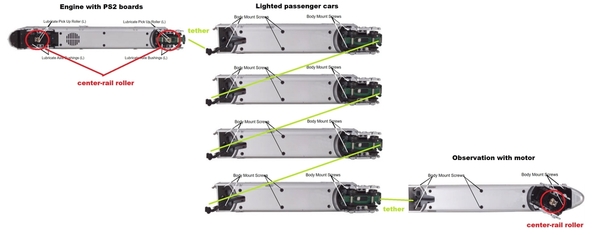Alright!!!! Once in awhile, if you are persistent,YOU STILL CAN WIN!!!!!
I RAN the Zephyr consist yesterday for about 2 solid hours with NO ADDITIONAL problems at all from the Additional cars!!!!!
So the train had 6 units(including the engine),and it ran superb at slow speeds,medium speed and PINNED at 120smph!!!on "088" Ross Track .The way that smoke comes out of the stack in 4 separate plumes is too cool!!!
That motor in the observation is DESIGNED to PUSH harder,the more load that is put in front on it.
At least that is what I was told by a well known MTH tech offline yesterday. He gave me the green light to hook it all together and run the daylights out of it!!!!
Looks like you could add as many cars as you can afford to purchase,(within reason)and I'm talking about the bigger cars in the set, which I will now have to get new name plates,customized, ,so it does not seem redundant.
But that is the least of my worries, now that I know you can string em' together,and the rear motor will compensate by itself to push harder,and then adjust again if you run a 3 car consist, as the original Zephyr did,before gaining popularity and adding additional cars to accomadate the demand for a seat on it.!!!
I never knew MTH made a motor setup like this,where it puts more power out if there is a bigger load to push!!!But then again,I've only been into MTH for 3 years now,it really looks like I missed the party 15-20 years ago.
A POSTWAR holdout.I did not want those fancy new expensive Korean trains,but now on the secondary and 3rd time being sold,I can finally afford to buy a couple here and there.And I'm so hooked I have completely forgot about that Lionel train Company
Thanks everyone for your help.I ran it again today for a couple hours solid,and NO MAGIC SMOKE!!!!(so far!!!) AH-ha-ha-ha -ha!!!!!!!!
I was able to put this all together for under $250.00,it looked bad when the first board died.
The engine would only run in conventional when I got it anyway.As I bought the engine separate,then added 2 cars,now I've added 3 more cars,a set box AND a new old stock chassis for the engine for $70.00!!
I was able to get a new board and have it installed in exchange for some of the Restoration work I do. After much trial and mostly error,I have stumbled upon methods that produce superior results!!
Someone also had kidnapped the Engineer guys ,so I stupid glued a Gang car guy in there.Now,with the NOS chassis,the Union guys have returned,and the gang car guy can collect his pension and Social Security check!!!!
Have a Blessed Day everybody!!And don't forget to VOTE on Wednesday,the future of our country is truly at stake.---Kenny Baughman











